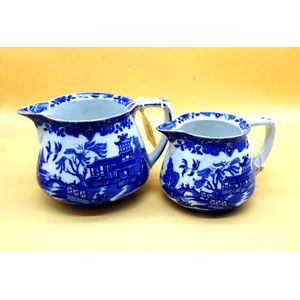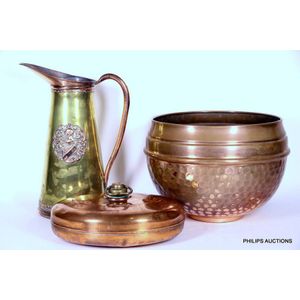English Copper Lustre Ware Jugs by Riddle & Bryan
You must be a subscriber, and be logged in to view price and dealer details.
Subscribe Now to view actual auction price for this item
When you subscribe, you have the option of setting the currency in which to display prices to $Au, $US, $NZ or Stg.
- Lustre Ware - Ceramics that have been coated with metallic oxides and then fired, to give a metallic finish, using a similar technique to, and sometimes resembling the irridescent finish on glass. Colours produced included silver (using platinum), gold, pink, white, copper and cream. Lustre ware was first made in England in the late 18th century. In the 19th century, many Staffordshire potteries produced lustre ware including Crown Devon, Royal Worcester, Carlton Ware, and Wedgwood. A lustre glaze was used very successfully by Belleek, in Country Fermanagh, Ireland. Many of their wares displayed a nautical theme including shell shapes, dolphins, and mer-boys.
- Manner of .... / Style of ..... - A cataloguing term where the item, in the opinion of the cataloguer is a work in the style of the artist, craftsman or designer, possibly of a later period.
- Circa - A Latin term meaning 'about', often used in the antique trade to give an approximate date for the piece, usually considered to be five years on either side of the circa year. Thus, circa 1900 means the piece was made about 1900, probably between 1895 and 1905. The expression is sometimes abbreviated to c.1900.
- Lustre Ware - Lustre decoration on ceramics is created by painting a thin deposit of metal oxide such as gold, silver or copper onto the surface, and then firing the item again, so that metal oxide forms a thin film on the surface. The finished effect is a shiny metallic surface. The technique was used in the 19th century by potteries such as Crown Devon, Grimwades, Maling, and Royal Doulton. However the best known use was by Wedgwood for its Fairyland lustre.
This item has been included into following indexes:
Visually similar items

Two antique Burleigh Ware Willow jugs, 11.2 cm high (tallest) approx.

Three vintage copper wares, late 19th to 20th century, a jardiniere with hammered decoration to the lower register, a copper and brass pitcher, and an oval hot water bottle, height 23 cm, diameter 32 cm, (pot)

English hallmarked sterling silver George V jug & sugar bowl of lotus shape, with reeded detail, engraved 'Cj Fhr 22.6.17'. Retailed for Fairfax & Roberts, London, 1913, maker marks rubbed, height of jug 7 cm, weight 157g

An Australian Federation commemorative beaker made by Royal Doulton, 1901, together with a similar restored beaker and an Advance Australia decorated jug, the beaker 10 cm high, the jug 12.5 cm high
